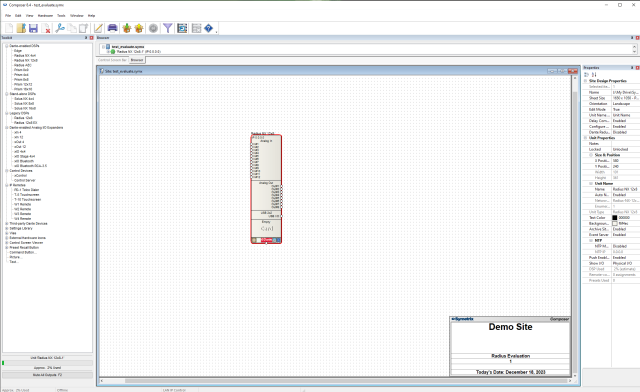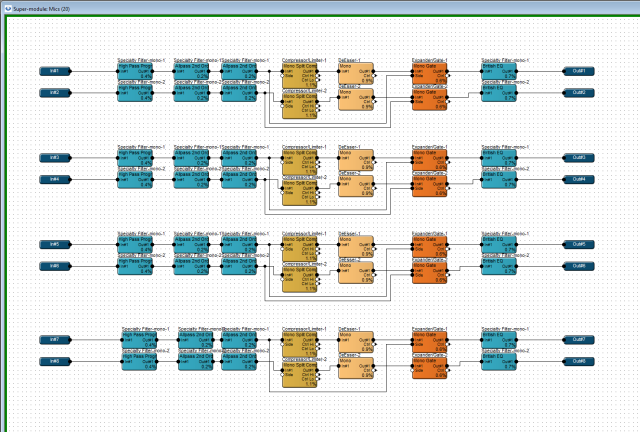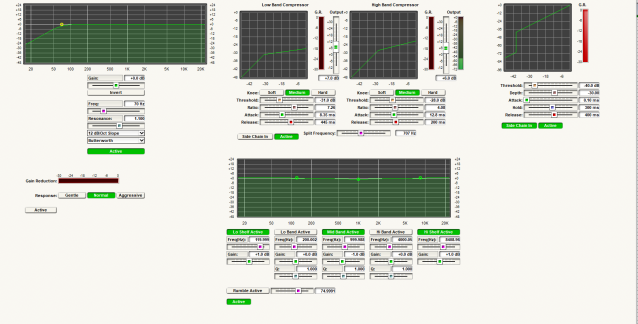Archive
Symetrix Radius NX 12×8 Part 2
Well, the holidays are upon us. Thanksgiving has flown by. How about some light reading. The Radius NX has been on the air on two stations for a few months now. No complaints. I do continue to think of ways to improve the sound, but if it works, lets not play too much, right?
I introduced the Symetrix in a previous post and here we will discuss the overall configuration of the unit. No this is not a box you just plug in and play like a discrete unit. This is a configurable DSP unit, so you need the tools to make it work. A drawback to modern technology and its flexibility is it requires the tools to do it. In the case of Symetrix their CAD like program is Composer. I started BEFORE I even received the hardware by downloading Composer from their site. This way I was able to poke and prod and start to learn what needs to be done.

As seen in the image, the workspace is very CAD-like which does make sense if you ponder it. The left side provides a toolkit. At the start you choose the DSP device of which to program. In my case the DSP is the Radius NX 12×8. Drag and drop in the workspace. Alternate click, aka Right-Click, and the basics of the device can be configured. I want to give a full tutorial, but really this is an overview. If you wish a more detailed description, or a tutorial type posting, please send a note and I can pursue a new site section for the crowd.
Moving on, double-click the DSP in the workspace opens the DSP configuration. This is the design view. Now the world of options opens up for you. The toolkit on the right changes with a number of DSP options or plug-ins to use. Many audio related, many facilities related. Remember Symetrix provides for the AV world and conference centers and business conference rooms are a big part of their business. As we are concentrating on broadcast studio use, we do not use the like of Loudspeaker management or Conferencing and paging.

You will also see the basics of the DSP unit, input and output “blocks”, and it will show Dante and AES if such options are installed. Open the Analog Ins by double clicking, same with the Analog Outs, and you see the controls for the I/O. From the toolkit you drag and drop in the modules, or blocks, which you wish to use.


I learned early on that designing from here can get quite messy. Just think of the modules you can have in this screen! After research, and around this time I was in contact with Symetrix, I learned about the Super-Module. Think of this as your container with the necessary, lets call them sub-modules, you wish to use in one package. In our case, we have 5 to 6 microphones in a control room, so if you did not create a super-module, you would have that many processing chains in this main design view, and what a view that would be. Package that into a super-module, then you see one of those, open that module up, and you build your chains out within that.
The next screenshot is after dropping in and configuring a new Super Module. Within this the audio I/O is filled based on the number of I/O you configure when creating it. Here we see 8 in and 8 out. Then you drag and drop the modules you wish to use; compressor, EQ, filters, and whatever complex stuff you wish to configure. Copy and paste? Yes. Makes things go faster, and if you have start-point settings, configure those first, then copy and past. Talk about saving time!

Once you add the audio path lines and save it all, you get audio in and audio out. The input gain and output trim interface with your external equipment, but once your audio is in, the DSP is all floating point, so there is almost unlimited gain. Just do not go crazy. I do the old fashioned approach by setting up my input and output, then make my changes to align with the external world after adjustment of the details.
Here is an EQ example. A specialty filter, or basically a pre-configured EQ module as you can build one yourself. All the settings are done for you and you can choose the type of EQ at each stage. This guy is a 5-band EQ. As you can see this becomes quite customizable.


That second image is a dual compressor/limiter that I have found to play with. Again a pre-loaded module. Easy to configure. Graphical. Note many of these modules have a side chain input. Use a different audio point to activate the module is pretty cool. Modules also have control inputs and those are used if you have zones and other types of controls to activate, etc. Not important, per se, to broadcast.
Once all this is done, you save it and upload it to the unit. If you have multiple units, you choose which one it goes to. Afterwards you can use Composer to make adjustments when you connect again. If you wish, you can save these “views” in SymView. When you run that, you connect directly and you have real-time changes without having to get into Composer. I for this I basically dropped, or exported, the settings to the SymView design.

After getting over that learning curve, which I will admit was daunting to start before having the hardware in hand, it became quite easy to navigate and move around. When I received our second unit, I had it up and running in no time. So far the talent in the studios that have a Symetrix NX in it have not complained. If asked for an adjustment, I am able to open the SymView for that installation and play. What worked out so well is I had it on my laptop. Walked into the room and had him yap while monitoring the appropriate bus, made a couple tweaks, and done. If you have remote access to your network, or a computer on the network, you can do these changes remotely, too. I have not been asked, but that day will come. At this point, if you are looking for a good unit with features galore, you can replace a number of single purpose boxes with a very versatile unit, I recommend the Symetrix. I feel I have come full circle when there was a time I had the trusted 528e.
Cheers!
Mic Processing Move: Welcome the Symetrix Radius 12×8
A few months back I mentioned we have moved some of our microphone processing from the Aphex Channel to a Symetrix Radius 12×8. I appreciate the patience you all exhibited while I juggled work, site migration, and whatever else life threw at me to finally get this, I should say these, posts rolling. Yes, these, as it will be best to provide you with a 3 or 4 post series on this migration from one manufacturer and technology to another. This first installment will give you the why and how the decision was made. After this comes the technical details and the meat that makes doing these things so much fun. Time to get things started with the “why” and WTF!
A reminder as it has been a while; since Rode purchased Aphex, support for the hardware has been poor, and quality control has gone downhill, too. This is the driving factor for moving on. I had a set of criteria before even looking at alternatives to the Aphex Channel. First a mic processing channel for me MUST have a noise gate, or some expander/gate. I did not want to budge on this one, nor have any demo unit passed this test. The second criteria was the unit required an AES, digital, output. I had to relax this requirement, though the Symetrix does give me an option. More on that in another installment. One must always be willing to compromise when faced with minimal alternatives.
How did I find this unit? Research. Lots of research. As we started to see more power supply failures on the Aphex units, pressure increased to find alternatives. The gate situation was becoming a sticking point. As Symetrix used to make a fine voice processor in the 528E, I poked into their website, here, and found a whole new world of devices. All are DSP based. I downloaded the software, Composer, used to configure these units. I learned a bit more. I contacted my preferred equipment vendor, Broadcasters General Store(name drop), and we started the inquiry process. It was slow to start, but once I was able to chat with a human at Symetrix, the details started to become clear. I was intrigued. Why not DSP? As I was having no luck with stand-alone units, I requested a demo. I originally asked for a Symetrix Prism, but a Radius 12×8 was available, so I went that route.

The hardware is deceptive and intimidating if you are expecting knobs, menus, meters, etc. As the picture shows, the hardware is just that, a chassis with some guts, and the guts need to be told what to do. I am glad I at least poked at the Composer software prior to having the physical unit here. I then had a great conversation with Stu at Symetrix. The chat gave me the necessary areas to focus on and details on what my end goals were. The Radius comes with analog and USB I/O be default, and the flavors are 4×4 and 12×8. I have the 12×8 because I have rooms with 5 to 6 mics. In addition, one can purchase the digital output module and/or a Dante module if you wish to go AoIP. I am considering adding the Dante module to a unit, the why to be discussed in a later installment. The digital output only gives 4 channels, so for a 5 to 6 mic room it is best to stay with analog.
After a few weeks of learning and playing with the Composer software, I had a multi-mic processor in a production studio for real use evaluation. Setting this up does take some learning, and the bottom line is it is a “process”. You start with a site. You add the hardware component, in this case a Radius 12×8. You then create a design which is the guts. I learned about super-modules. I learned the different filters and dynamics that are available. I ignored the items in the toolkit which refer to conferencing, control surfaces, and mixers. Yes, you may say overkill for just a processor, but as you will see in the next installment, the fine tuning and tweaking flexibility does pay off. When all was tested in the production room, I had a concept mic channel with the desired stages ready for on air. I will admit when I purchased our second unit I changed a couple items in the chain which seems to have improved on my original concept. I now have a mic channel strip copied to 8, so each mic is able to be configured individually, and using SymView, I do not need to be connected to Composer for minor tweaks. My DSP channel is basic in terms of the basics: after the input where levels are set, I have the high-pass filter, compressor, de-esser, expander/gate, and EQ as one would expect from a stand-alone processor.
The Symetrix Radius has been on the air now for a few months, and I have received positive feedback. I learned the Radius comes with a better mic pre-amp than the Prism, so that factored into the decision. The unit provides phantom power as I use Neumann BCM-104 microphones. Did it take time to learn? Yes. Is it the same as an Aphex Channel? No. Does it sound clean? Yes. Other factors that were a concern was how well the DSP compressor works, how to deal with make-up gain, and latency through the unit. The former concerns are minor as we know how to make the appropriate adjustments. The latter was a bit more concerning, but once on air, it is not. It depends on how you build your stages and how much DSP is being used. The next installment will describe how I used Composer and built the stages, with screenshots, as an example of what the learning curve involves. I must say I like the flexibility, and DSP can be your friend.